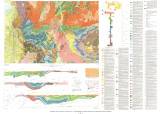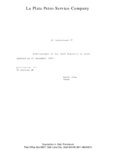TO
Filters: Collection: "ir_eua"
| Title | Date | Subject | Description | ||
|---|---|---|---|---|---|
| 1 |
 |
Geology of the Mill Fork Area, Utah | 1972-12 | geology; Mill Fork area; geologic structure; Green River formation | The Mill Fork area comprises about 70 square miles of Cretaceous ( ? ) and Tertiary sediments at the northern end of the Wasatch Plateau in Utah County, Utah. Over 9000 feet of nonmarine sediments are present and belong to the North Horn, Flagstaff, and Green River formations. These sediments record... |
| 2 |
 |
Energy resources map of Utah (no. 68) | 1983-05 | Map 68; Utah; Energy Resources map; Gilsonite; Oil shale; Oil-impregnated rock; Geology; Oil and natural gas | |
| 3 |
 |
Utah energy developments: A summary of existing and proposed activity 1981-1990 | 1981-06 | energy developments; Utah energy developments; Utah Energy Information System | This report on Energy Developments in Utah is designed to provide local, state, federal and private sector decision makers with current information on existing and planned energy developments in the State. Rather than focussing on the demand or supply for energy resources in the State, this report f... |
| 4 |
 |
Utah's tar sand resource: Geology, politics, and economics | 1976 | Utah tar sand; tar sand resource; geology; politics; economics; oil-impregnated rock deposits; oil shale; tar sands | Twelve of fifty deposits of oil-impregnated rock in Utah contain 98 percent of the 26 billion barrels estimated in place. This is about 90 to 95 percent of the total mapped U.S. resource. Several deposits have been and are mined for paving material. Extraction of oil from three deposits is beginning... |
| 5 |
 |
Field guide to lacustrine and related nonmarine depositional environments in tertiary rocks, Uinta Basin, Utah | 1976-11 | lacustrine environments; nonmarine depositional environments; tertiary rocks | The lower part of the Tertiary System in the Uinta Basin of northeastern Utah and northwestern Colorado (fig. 1) reflects a series of very complex and variable forms of continental sedimentation in a basin of internal drainage. These complex forms represent the disruption of the Cretaceous depositio... |
| 6 |
 |
Control strategies for abandoned in situ oil shale retorts | 1979-04 | In situ oil shale retorting may result in a number of environmental impacts including degradation of local surface and groundwaters, low resource recovery and subsidence. The target of present oil shale commercialization activities is the Mahogany zone in Colorado's Piceance Creek Basin. The princip... | |
| 7 |
 |
Potential hydrologic impacts of a tar-sand industry in 11 special tar sand areas in eastern Utah | 1983 | crude oil tar-sand deposits; U.S. Bureau of Land Management; Tar Sand Triangle area; hydrolic impact | About 93 percent of the Nation's estimated 30 billion barrels of crude oil in tar-sand deposits is in 11 areas in eastern Utah that were chosen for leasing by the U.S. Bureau of Land Management. The largest deposit, which is in the Tar Sand Triangle area, contains about 15 billion barrels of oil. Th... |
| 8 |
 |
Geologic map of the Salt Lake City 30' X 60' quadrangle, north-central Utah, and Uinta County, Wyoming | 1990 | ||
| 9 |
 |
Oil-impregnated rock deposits of Utah | 1974-07 | ||
| 10 |
 |
Resource evaluation of selected tar-sand deposits in southern Oklahoma | 1987-11-02 | resource evaluation; tar-sand deposits; southern Oklahoma; sulphur deposit; bitumen content | The cooperative program between the Oklahoma Geological Survey and the U.S. Department of Energy has permitted evaluation of specific tar-sand deposits in Carter and Murray counties, Oklahoma. The Sulphur deposit was evaluated by a combination of industry and DOE-OGS boreholes. Bitumen content of th... |
| 11 |
 |
Mineralogy of oil shale in the upper part of Parachute Creek member of the Green River Formation in the Eastern Uinta Basin, Utah | 1976 | Parachute Creek; Green River Formation; Uinta Basin; Utah; X-ray diffraction; Oil shale; Curly bed; Wavy bed tuffs; Mahogany zone; Naval Oil Shale Reserve No. 2; Federal Prototype Oil Shale Leas Tract Ua; Smectite; Mineralogy | The relative abundance and distribution of major and minor minerals have been determined by X-ray diffraction for samples of Green River Formation oil shale in three drill cores from the eastern part of the Uinta Basin, Utah. The samples in each core are from the same rock stratigraphic interval bet... |
| 12 |
 |
Bituminous sandstone and limestone deposits of Utah | 1963 | The significant bituminous sandstone and bituminous Limestone deposits of Utah are located within, or on the edges of, the Uinta Basin. They are all located within the boundaries of Carbon, Duchesne, and Uintah Counties. The Sunnyside deposits in Carbon County contain the greatest reserves of bitumi... | |
| 13 |
 |
1884-85 General Catalog | 1884 | University of Utah catalogue; (Catalog) | Annual of the University of Deseret, 1884-85 |
| 14 |
 |
Core-based integrated sedimentologic, stratigraphic, and geochemical analysis of the oil shale bearing Green River Formation, Uinta Basin, Utah | 2011-04 | Utah; Green River Formation; Lake Uinta; Mahogany zone; Lake evolution; Oil shale development; Uinta Basin | An integrated detailed sedimentologic, stratigraphic, and geochemical study of Utah's Green River Formation has found that Lake Uinta evolved in three phases 1) a freshwater rising lake phase below the Mahogany zone, 2) an anoxic deep lake phase above the base of the Mahogany zone and 3) a hypersali... |
| 15 |
 |
Chapter 14 | |||
| 16 |
 |
Bibliography of oil-impregnated rock deposits of Utah | 1979-11 | ||
| 17 |
 |
Geology and tar sand resource Nine Mile Ranch and vicinity Carbon County, Utah: Sunnyside and Cottonwood-Jack Canyon tar sand deposits | 1984-03 | tar sand resource; oil production; Nine Mile Ranch; geology; Sunnyside; Cottonwood-Jack Canyon; tar sand deposits | A very major tar sand resource is located within the study area. This is estimated on a reconnaissance basis at 4.16 billion barrels (gross) of oil in place in beds from a few to more than 700 feet in thickness extending over about 39,400 acres. About 2.50 billion barrels of the total is on lands co... |
| 18 |
 |
Economic & demographic futures 1980-2000 | 1980-01 | Special acknowledgement is appropriate for the efforts of the Community Planning Policy Committee which provided continual guidance to the Water Quality staff over a six month period; in addition to Jean Watanbe, Office of the State Planning Coordinator, Brad Barber and Greg Selby formerly with the ... | |
| 19 |
 |
Utah experimental census of population 1956 Nebo school district | 1956 | The Nebo School District comprises all of Utah County, Utah. lying south of the southern boundary of the corporate limits of Provo City. Major population centers included are Springville, Spenish Fork and Payson. | |
| 20 |
 |
Evaluation of the Utah oil sand resource | 1976-08 | oil sand deposits; Utah oil sand; oil sand resource; Tar Sand Triangle; P. R. Spring; Sunnyside deposits; hydrocarbons; surface mining of oil sands | The three largest oil sand deposits in Utah, namely, the Tar Sand Triangle, the P.R. Spring, and the Sunnyside deposits, have been studied to contribute data relative to the surface and insitu mining of these deposits and to recommend research that should be conducted to develop the Utah oil sand re... |
| 21 |
 |
Bibliography of tar sand deposits in Utah | 1987 | ||
| 22 |
 |
Chapter 9 | |||
| 23 |
 |
Chapter 16 | |||
| 24 |
 |
Chapter 12 | |||
| 25 |
 |
Process for separating high viscosity bitumen from tar sands | 1984-12-04 | separating bitumen from tar sand; high viscosity bitumen; tar sand; bitumen recovery; patent | A novel process for separating high viscosity bitumen from tar sand. The process includes grinding the tar sand to obtain phase disengagement of the bitumen phase from the sand phase and thereafter using flotation techniques to obtain phase separation of the bitumen phase from the sand phase. Phase ... |
